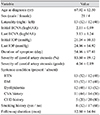1. Terelak-Borys B, Skonieczna K, Grabska-Liberek I. Ocular ischemic syndrome: a systematic review. Med Sci Monit. 2012; 18:RA138–RA144.
2. Mizener JB, Podhajsky P, Hayreh SS. Ocular ischemic syndrome. Ophthalmology. 1997; 104:859–864.
3. Magargal LE, Sanborn GE, Zimmerman A. Venous stasis retinopathy associated with embolic obstruction of the central retinal artery. J Clin Neuroophthalmol. 1982; 2:113–118.
4. Lyons-Wait VA, Anderson SF, Townsend JC, De Land P. Ocular and systemic findings and their correlation with hemodynamically significant carotid artery stenosis: a retrospective study. Optom Vis Sci. 2002; 79:353–362.
5. Kearns TP. Differential diagnosis of central retinal vein obstruction. Ophthalmology. 1983; 90:475–480.
6. Lazzaro EC. Retinal-vein occlusions: carotid artery evaluation indicated. Ann Ophthalmol. 1986; 18:116–117.
7. North American Symptomatic Carotid Endarterectomy Trial Collaborators. Beneficial effect of carotid endarterectomy in symptomatic patients with high-grade carotid stenosis. N Engl J Med. 1991; 325:445–453.
8. Mills RP. Anterior segment ischemia secondary to carotid occlusive disease. J Clin Neuroophthalmol. 1989; 9:200–204.
9. Sivalingam A, Brown GC, Magargal LE, Menduke H. The ocular ischemic syndrome. II: Mortality and systemic morbidity. Int Ophthalmol. 1989; 13:187–191.
10. Brown GC, Magargal LE. The ocular ischemic syndrome. Clinical, fluorescein angiographic and carotid angiographic features. Int Ophthalmol. 1988; 11:239–251.
11. Sivalingam A, Brown GC, Magargal LE. The ocular ischemic syndrome. III: Visual prognosis and the effect of treatment. Int Ophthalmol. 1991; 15:15–20.
12. Mendrinos E, Machinis TG, Pournaras CJ. Ocular ischemic syndrome. Surv Ophthalmol. 2010; 55:2–34.
13. Sivak-Callcott JA, O'Day DM, Gass JD, Tsai JC. Evidence-based recommendations for the diagnosis and treatment of neovascular glaucoma. Ophthalmology. 2001; 108:1767–1776.
14. Shazly TA, Latina MA. Neovascular glaucoma: etiology, diagnosis and prognosis. Semin Ophthalmol. 2009; 24:113–121.
15. Ino-ue M, Azumi A, Kajiura-Tsukahara Y, Yamamoto M. Ocular ischemic syndrome in diabetic patients. Jpn J Ophthalmol. 1999; 43:31–35.
16. Chen KJ, Chen SN, Kao LY, et al. Ocular ischemic syndrome. Chang Gung Med J. 2001; 24:483–491.
17. Guo T, Zhang HR. Clinical features and carotid artery color Doppler imaging in patients with ocular ischemic syndrome. Zhonghua Yan Ke Za Zhi. 2011; 47:228–234.
18. Cheng Y, Qu J, Chen Y, et al. Anterior segment neovascularization in diabetic retinopathy: a masquerade. PLoS One. 2015; 10:e0123627.
19. Karacostas D, Terzidou C, Voutas S, et al. Isolated ocular ischemic syndrome with no cerebral involvement in common carotid artery occlusion. Eur J Ophthalmol. 2001; 11:97–101.
20. Alizai AM, Trobe JD, Thompson BG, et al. Ocular ischemic syndrome after occlusion of both external carotid arteries. J Neuroophthalmol. 2005; 25:268–272.
21. Kawaguchi S, Okuno S, Sakaki T, Nishikawa N. Effect of carotid endarterectomy on chronic ocular ischemic syndrome due to internal carotid artery stenosis. Neurosurgery. 2001; 48:328–332.
22. Brown GC, Magargal LE, Simeone FA, et al. Arterial obstruction and ocular neovascularization. Ophthalmology. 1982; 89:139–146.
23. Kerty E, Horven I. Ocular hemodynamic changes in patients with high-grade carotid occlusive disease and development of chronic ocular ischaemia. I: Doppler and dynamic tonometry findings. Acta Ophthalmol Scand. 1995; 73:66–71.
24. Kerty E, Eide N, Horven I. Ocular hemodynamic changes in patients with high-grade carotid occlusive disease and development of chronic ocular ischaemia. II: Clinical findings. Acta Ophthalmol Scand. 1995; 73:72–76.
25. Wagner WH, Weaver FA, Brinkley JR, et al. Chronic ocular ischemia and neovascular glaucoma: a result of extracranial carotid artery disease. J Vasc Surg. 1988; 8:551–557.
26. Higgins RA. Neovascular glaucoma associated with ocular hypo perfusion secondary to carotid artery disease. Aust J Ophthalmol. 1984; 12:155–162.
27. Han YS, Yoo WS, Chung IY, Park JM. Ocular ischemic syndrome successfully treated with carotid angioplasty and stenting. J Korean Ophthalmol Soc. 2010; 51:447–452.








 PDF
PDF ePub
ePub Citation
Citation Print
Print




 XML Download
XML Download